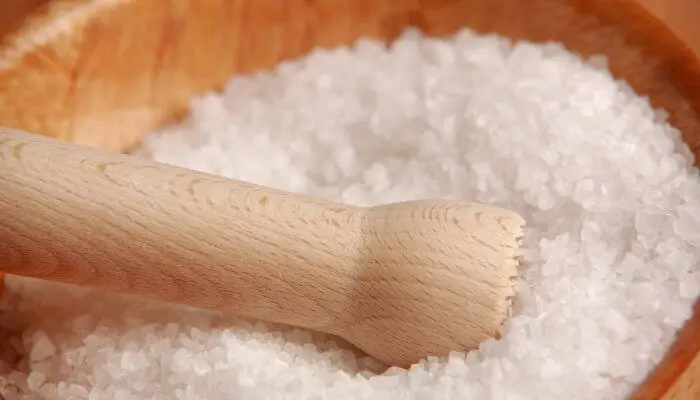Salt is an essential flavor enhancer and a great food preservative.
However, it’s also hygroscopic, which means that it absorbs moisture in the air and gets damp easily.
Thankfully, there are several tricks that can help you figure out how to keep salt dry.

1. Mix Uncooked Rice With The Salt
Rice is often the go-to choice for keeping salt dry since it’s hygroscopic, cheap, and readily available.
Here’s what you need to do:
- Mix in a few grains of uncooked rice in your salt container.
- If you’re storing it in a shaker, get larger grains that won’t fall through the holes.
- You may have to change the rice every once in a while as it reaches a saturation point where it stops absorbing moisture.
Sometimes, old grains tend to break, turn to powder, and get lost in the salt. Still, rice has worked well for many, and it’ll likely work for you!
2. Mix Coffee Beans With The Salt
Placing a couple of coffee beans in the container is another choice to keep salt dry. They’re also a desiccant but not as low-cost as rice.
Just keep in mind that the salt will gain a hint of coffee aroma over time. However, the taste will mostly stay the same.
3. Use Dry Crackers
Adding crackers to your salt box may sound unusual, but some people do so, and it works for them. After all, the presence of sugars and starches can help in absorbing moisture.
Here’s how you can use dry crackers:
- Break the cracker (saltine or plain biscuits) into smaller pieces if it doesn’t fit into the container.
- Add the pieces to the container and top with salt.
- Make sure to replace the cracker occasionally (10 to 15 days), as it gets soggy when it absorbs enough moisture.
4. Mix In Pasta Pieces
Pasta is very similar to rice and can keep salt free of moisture. You’ll just need to pick the right shape and size:
- If you have larger pasta, like uncooked spaghetti, break it into small enough pieces to fit in the salt container.
- Macaroni or medium shell pasta is the same size as coffee and kidney beans, so you can add a few whole pieces.
- Smaller pasta, like orzo, is shaped like long-grain rice and should work just the same.
On the plus side, the pasta can even add a decorative flair to your salt container!
5. Use Dried Parsley
Dried parsley is an interesting choice to keep salt dry since it not only absorbs moisture but also adds aroma and flavor.
Here’s how you can add dried parsley to salt:
- Mince the dried parsley leaves, but don’t overdo it so the parsley won’t fall through the shaker.
- Fill up at least ¼ of the shaker with the chopped parsley.
- Add the salt over it and mix.
6. Mix In Dried Kidney Beans
Much like coffee, kidney beans can do the trick by keeping the moisture from ruining the salt, but they won’t alter the aroma.
All you need to do is add a few dried kidney beans and scatter them evenly in the container to prevent clumping.
You can also use other bean types like white, black, or pinto beans.
7. Mix In Whole Cloves
Cloves, like parsley, keep salt dry while adding aroma and flavor, but they can be a bit more intense.
If you don’t mind the scent, put some whole cloves larger than the shaker holes in the bottom, add the salt, and seal.
What Is the Best Container to Keep Salt in to Keep It Dry?
Let’s look at the best containers to keep your salt in the best condition!
A Salt Box
Not every salt box is perfect for storage, especially for the long term. First, you have to consider what kind of material it’s made of.
It’s better to avoid cardboard, plastic, and metal boxes as they let moisture in and can even contaminate salt with chemicals and corrosion.
Salt boxes made of wood, glass, or ceramic can be better at keeping moisture out.
Ceramic or Clay Container With a Sealed Lid
Ceramics or clay have long been used for food storage since the Neolithic period. Overall, the material is great for long-term storage and good for the environment.
Just make sure to pick something non-porous (like porcelain), food-grade, and with a sealed lid to make the container airtight.
A Glass Container With a Sealed Lid
A glass container is practically the same as a ceramic or clay container.
It’s non-porous and keeps moisture out with a proper airtight seal. So, it serves a similar purpose of preserving salt for long-term storage.
However, it might not be ideal if you want to cover up the desiccants from plain sight.
Conclusion
There are several methods to keep salt dry; luckily, most of these include ingredients readily available in your pantry.
Uncooked rice, coffee beans, kidney beans, crackers, dried parsley, and cloves can all effectively absorb moisture.
Plus, it’s best to store your salt beforehand in proper containers to reduce exposure to humid air.

